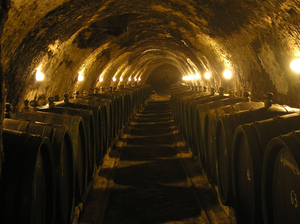قبو (مخزن)
مصطلح قبو (أو كانتينا- storage room) يدل على مكان تحت الأرض يُستعمل لتخزين وحفظ الأغذية والمشروبات و بشكل خاص الخمور والمشروبات الروحية والمنتجات العامة قبل البيع أو الاستهلاك.
قيمة الرطوبة النسبية في القبو ينبغي أن تكون دائما ما بين 70 إلى 80 ٪ ، وأفضل حتى لو أكثر من 80.
استنادا إلى الخبرة قد تبين أن درجة الحرارة المثلى هي 10-12 درجة مئوية للنبيذ الأبيض و 12-14 درجة مئوية للنبيذ الاحمر
قبو يجب ان يكون مظلم أو بالأحرى لا ينبغي أن يكون هناك ضوء يرفع درجة الحرارة.
فمن الضروري تجنب وجود روائح غير مرغوب فيها. ولذلك يجب تجنب تخزين أي مواد كيميائية او وقود (ديزل بنزين) ، علب الطلاء ، المنظفات ، الصابون ، وحتى الموادالتي تتعفن بسرعة مثل الورق والورق المقوى.
الغرض
Wine cellars protect alcoholic beverages from potentially harmful external influences, providing darkness, constant temperature, and constant humidity. Wine is a natural, perishable food product issued from fermentation of fruit. Left exposed to heat, light, vibration or fluctuations in temperature and humidity, all types of wine can spoil. When properly stored, wines not only maintain their quality but many actually improve in aroma, flavor, and complexity as they mature. Depending on their level of sugar and alcohol, wines are more or less sensitive to temperature variances; wine with higher alcohol and/or sugar content will be less sensitive to temperature variance.[بحاجة لمصدر]
الحالة
Wine can be stored satisfactorily between 7–18 °C (45–64 °F) as long as any variations are gradual. A temperature of 13 °C (55 °F), much like that found in the caves used to store wine in France, is ideal for both short-term storage and long-term aging of wine. Wine generally matures differently and more slowly at a lower temperature than it does at a higher temperature.[1] When the temperature swings are significant, 14 degrees or more, it will cause the wine to breathe through the cork which significantly speeds up the aging process. Between 10–14 °C (50–57 °F), wines will age normally.[2]
فعال مقابل سلبي
Wine cellars can be either active or passively cooled. Active wine cellars are highly insulated and need to be properly constructed. They require specialized wine cellar conditioning and cooling systems to maintain the desired temperature and humidity. In a very dry climate, it may be necessary to actively humidify the air, but in most areas this is not necessary. Passive wine cellars must be located in naturally cool and damp areas with minor seasonal and diurnal temperature variations, for example, a basement in a temperate climate. Passive cellars may be less predictable, but cost nothing to operate and are not affected by power outages.[بحاجة لمصدر]
الرطوبة
Some wine experts debate the importance of humidity for proper wine storage. In the Wine Spectator, writer Matt Kramer noted a French study which claimed that the relative humidity within a bottle is maintained 100% regardless of the closure used or the orientation of the bottle.[3] However, Alexis Lichine says that low humidity can be a problem because it may cause organic corks to dry prematurely. One inch (2.5 cm) of gravel covering the floor periodically sprinkled with a little water was recommended to retain the desired humidity.[2]
معرض صور
A table for drinking and gathering in a Sonoma wine cellar
Wine bottles stored in a wine cellar at Jesus College, Oxford
Mileștii Mici has the world's biggest wine cellars.
Wine cellar of Schramsberg Vineyards, Napa
A sherry solera over the ground
An above ground wine cellar in Runcu - Romania
The former nymphaeum at the Hôtel de Besenval after its transformation into a wine cellar in 2024
انظر أيضاً
- قبو
- Storage of wine
- Aging of wine
- CellarTracker (database)
المراجع
- ^ Walder, Gene. "The Science of Aging Wine". Vintage Cellars. Retrieved 28 November 2011.
- ^ أ ب Lichine, Alexis (1967). Alexis Lichine's Encyclopedia of Wines and Spirits. London: Cassell & Company Ltd. Ch. 6, pp. 22–24.
- ^ Kramer, Matt (October 31, 2007). "Seeking Closure". The Wine Spectator. p. 36.
قالب:Winemaking خطأ لوا في وحدة:Authority_control على السطر 278: attempt to call field '_showMessage' (a nil value).









